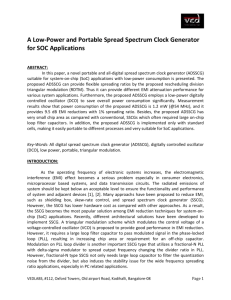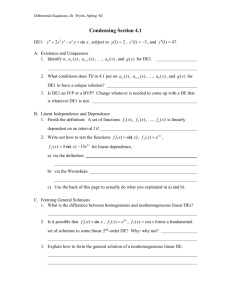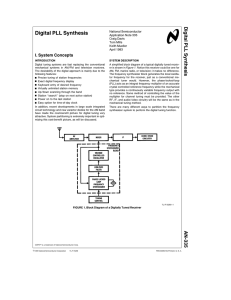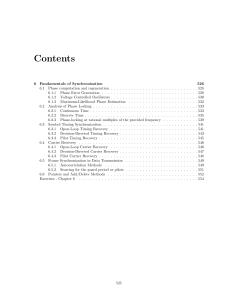A Portable and Wide Banded High-Speed ADPLL Using Novel Compensation Technique
advertisement
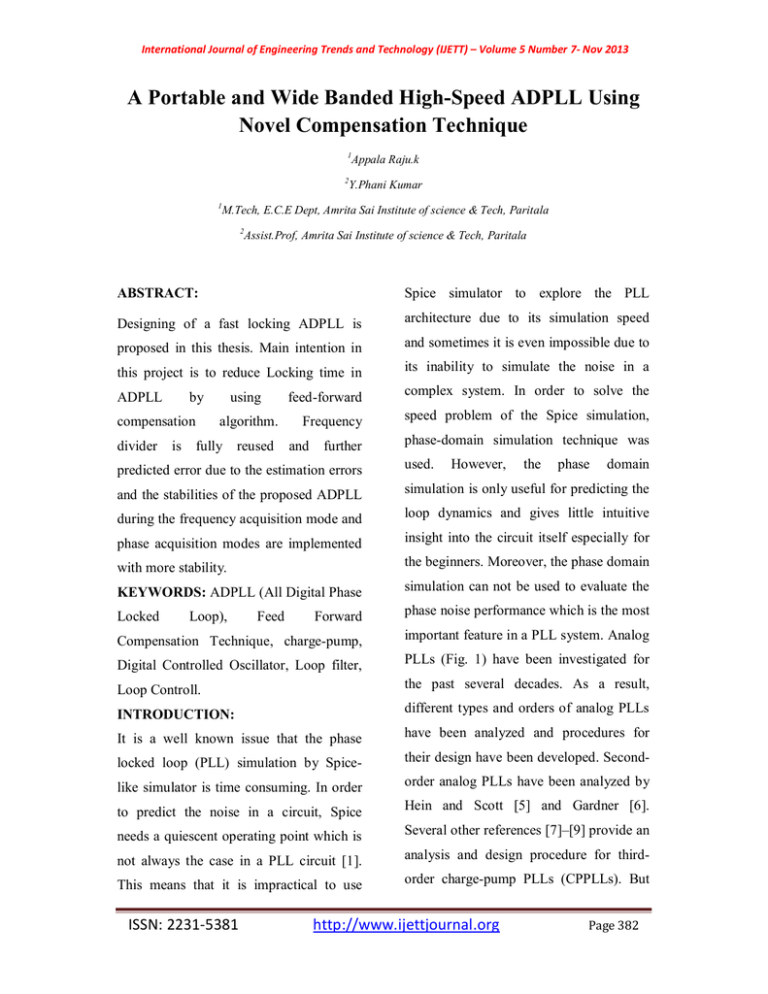
International Journal of Engineering Trends and Technology (IJETT) – Volume 5 Number 7- Nov 2013 A Portable and Wide Banded High-Speed ADPLL Using Novel Compensation Technique 1 2 1 Appala Raju.k Y.Phani Kumar M.Tech, E.C.E Dept, Amrita Sai Institute of science & Tech, Paritala 2 Assist.Prof, Amrita Sai Institute of science & Tech, Paritala ABSTRACT: Spice simulator to explore the PLL Designing of a fast locking ADPLL is architecture due to its simulation speed proposed in this thesis. Main intention in and sometimes it is even impossible due to this project is to reduce Locking time in its inability to simulate the noise in a ADPLL feed-forward complex system. In order to solve the Frequency speed problem of the Spice simulation, by compensation divider is using algorithm. fully reused and further phase-domain simulation technique was predicted error due to the estimation errors used. and the stabilities of the proposed ADPLL simulation is only useful for predicting the during the frequency acquisition mode and loop dynamics and gives little intuitive phase acquisition modes are implemented insight into the circuit itself especially for with more stability. the beginners. Moreover, the phase domain KEYWORDS: ADPLL (All Digital Phase simulation can not be used to evaluate the Locked Forward phase noise performance which is the most Compensation Technique, charge-pump, important feature in a PLL system. Analog Digital Controlled Oscillator, Loop filter, PLLs (Fig. 1) have been investigated for Loop Controll. the past several decades. As a result, INTRODUCTION: different types and orders of analog PLLs It is a well known issue that the phase have been analyzed and procedures for locked loop (PLL) simulation by Spice- their design have been developed. Second- like simulator is time consuming. In order order analog PLLs have been analyzed by to predict the noise in a circuit, Spice Hein and Scott [5] and Gardner [6]. needs a quiescent operating point which is Several other references [7]–[9] provide an not always the case in a PLL circuit [1]. analysis and design procedure for third- This means that it is impractical to use order charge-pump PLLs (CPPLLs). But Loop), ISSN: 2231-5381 Feed However, http://www.ijettjournal.org the phase domain Page 382 International Journal of Engineering Trends and Technology (IJETT) – Volume 5 Number 7- Nov 2013 there is only limited research dedicated to the analysis of all-digital PLLs (ADPLLs). OVERVIEW OF ALL-DIGITAL PLLS A simplified block diagram of the alldigital PLL for a microprocessor or serial link application is shown in Fig. 2. It consists of a phase-to-digital converter (P2D), a digital loop filter (LF), a digitally controlled oscillator (DCO), and a feedback divider. The P2D senses the phase difference between the reference Clock Fref and the DCO divided clock FCKV and converts it to a digital format. This information is filtered by the firstorder digital LF and then is used to control the DCO. In the case of a ring-oscillatorbased DCO, frequency tuning can be performed by digitally turning on and off bias current sources. When an LC-based DCO is employed, frequency tuning is done by switching on and off the tank capacitors. The P2D can be implemented Fig. 1. Typical implementation of a P2D converter They are overlapped by an OR gate to create a pulse, the width of which is proportional to the absolute value of the phase error. The width of this pulse is digitized by a TDC with a resolution DELTA and an-bit output ABS is produced. The D-flip-flop samples the UP pulse on the rising edge of the DN pulse. In this manner, the sign of the phase/frequency error can be determined. inmany differentways. Oneway, shownin Fig. 1, features phase/frequency a conventional detector (PFD) followedby a time-to-digital converter. It is beneficial to use a PFD instead of just a phase detector in order to expand the frequency lock range. ThePFDproduces up (UP) and down(DN) pulses. Figure 2. Conception of the feed-forward PLL. The PFD detects the difference in phase and frequency between the reference clock and feedback clock inputs and generates an “up” or “down” control signal based on ISSN: 2231-5381 http://www.ijettjournal.org Page 383 International Journal of Engineering Trends and Technology (IJETT) – Volume 5 Number 7- Nov 2013 whether the feedback frequency is lagging equal to (M) times the input reference or leading the reference frequency. These clock (FREF). The PFD input reference “up” or “down” control signals determine clock (FREF) is equal to the input clock whether the VCO needs to operate at a (FIN) divided by the pre-scale counter (N). higher or lower frequency, respectively. Therefore, the feedback clock (FFB) The PFD outputs these “up” and “down” applied to one input of the PFD is locked signals to a charge pump. If the charge to the FREF that is applied to the other pump receives an up signal, current is input of the PFD. The VCO output feeds driven into the loop filter. Conversely, if it post-scale counters which allow a number receives a down signal, current is drawn of harmonically related frequencies to be from the loop filter. produced within the PLL. The loop filter converts these signals to a The output frequency of the PLL is equal control voltage that is used to bias the to the VCO frequency (FVCO) divided by VCO. Based on the control voltage, the the post-scale counter (C). VCO oscillates at a higher or lower In the form of equations: frequency, which affects the phase and • FREF = FIN / N frequency of the feedback clock. If the • FVCO = FREF × M = FIN × M/N PFD produces an up signal, then the VCO • FOUT = FVCO / C = (FREF × M) frequency / C = (FIN × M) / (N × C) increases. A down signal decreases the VCO frequency. The VCO where: stabilizes once the reference clock and the • FVCO = VCO frequency feedback clock have the same phase and • FIN = input frequency frequency. The loop filter filters out jitter • FREF = reference frequency by removing glitches from the charge • FOUT = output frequency pump and preventing voltage over-shoot. • M = counter (multiplier), part of When the reference clock and the feedback the clock feedback path clock are aligned, the PLL is considered • locked. To find reasons why a PLL may input clock reference path lose lock, see Why Does My PLL Lose • Lock? PROPOSED FEED-FORWARD A divide counter (M) is inserted in the COMPENSATION ALGORITHM: feedback loop to increase the VCO The proposed feed-forward all-digital PLL frequency above the input reference system is shown in Fig. 3. The input frequency. VCO frequency (FVCO) is reference can be either a frequency control ISSN: 2231-5381 N = counter (divider), part of the C = post-scale counter (divider) http://www.ijettjournal.org Page 384 International Journal of Engineering Trends and Technology (IJETT) – Volume 5 Number 7- Nov 2013 word (FCW) as in [5], or the output of a function (FF function in Fig.3) is a frequency to digital converter (FDC) or mathematical operator as will be shown time to digital converter (TDC) similar to later. The digital controlled oscillator the one in the feed-back path as proposed (DCO) can be either a digitally controlled in [5-6]. The phase-detector (PD) is just an inverter chain ring oscillator or LC adder, and the low pass filter (LPF) is a oscillator. digital low-pass filter. The feed-forward Figure 3: LPF . Figure 4. ADPLL feed-forward model. A linear model of the feed-forward is ΚDCO/Κ^DCO, ffree is the free running ADPLL is shown in Fig. 4 adapted to estimating the DCO’s gain. include the feed-forward path and scaling factors from [5]. The input reference Δf/fR is the time step unit value reference, N is the ratio between the wanted frequency at the output of the PLL and the reference frequency fR. The function F(z) is the digital low-pass transfer function while K^DCO is the DCO gain scaling constant. KDCO is the DCO gain constant, Κ’DCO ISSN: 2231-5381 http://www.ijettjournal.org Page 385 International Journal of Engineering Trends and Technology (IJETT) – Volume 5 Number 7- Nov 2013 RESULTS: REFERENCES: [1] R. B. Staszewski, D. Leipold, K. Muhammand, and P. T. Balsara, “Digitally controlled oscillator (DCO)-based architecture for RF frequency synthesis in a deep-submicrometer CMOS process,” IEEE Trans. Circuits Syst. II, Analog Digit. Signal Process., vol. 50, no. 11, pp. 815–822, Nov. 2003. [2] J. Lin, B. Haroun, T. Foo, J.-S. Wang, APPLICAIONS: ADPLL is used as Counter-Based Mode Switching Controller for multi purpose counting and storage applications. This can be used in all type of communications Barr, and J. Kirkpartick, “A PVT tolerant 0.18 MHz to 600 MHz self-calibrated digital PLL in 90 nm CMOS process,” in Dig. Tech. Papers ISSCC’04, Feb. 2004, like OFDM, CDMA Etc. Scientific CRO s is mainly constructed with ADPLLs. ADPLL in these C.R.O.s are used to generate all type of different voltage signals and current signals. pp. 488–489. [3] P. Raha, S. Randall, R. Jennings, B. Helmick, A. Amerasekera, and B. Haroun, “A robust digital delay line architecture in a 0.13-m CMOS technology node for CONCLUSION: A fast locking ADPLL is proposed in this paper is used to reduce the locking time of ASPLL. A feed-forward compensation algorithm; proposed in this ADPLL is used to generate all signals with less execution time. Furthermore, the frequency divider is fully reused. The predicted error due to the estimation errors and the stabilities of the proposed ADPLL during the frequency acquisition mode and phase acquisition mode are designed. B. Helmick, S. Randall, T. Mayhugh, C. reduced design and process sensitivities,” in Proc. ISQED’02, Mar. 2002, pp. 148– 153. [4] T. Olsson and P. Nilsson, “Portable digital clock generator for digital signal processing applications,” Electron. Lett., vol. 39, pp. 1372–1374, Sep. 2003. [5] E. Roth, M. Thalmann, N. Felber, and W. Fichtner, “A delay-line based DCO for multimedia applications using digital standard cells only,” in Dig. Tech. Papers ISSCC’03, Feb. 2003, pp. 432–433. [6] C.-C. Chung and C.-Y. Lee, “An all digital phase-locked loop for highspeed ISSN: 2231-5381 http://www.ijettjournal.org Page 386 International Journal of Engineering Trends and Technology (IJETT) – Volume 5 Number 7- Nov 2013 clock generation,” IEEE J. Solid-State Circuits, vol. 38, no. 2, pp. 347–351, Feb. 2003. [7] J. M. Rabaey, Digital Integrated Circuits—A Design Perspectives. Englewood Cliffs, NJ: Prentice-Hall, 1996. [8] I. Hwang, S. Lee, S. Lee, and S. Kim, “A digitally controlled phaselocked loop with fast locking scheme for clock synthesis application,” ISSCC Dig. Tech. Papers, pp. 168–169, Feb. 2000. ISSN: 2231-5381 http://www.ijettjournal.org Page 387
